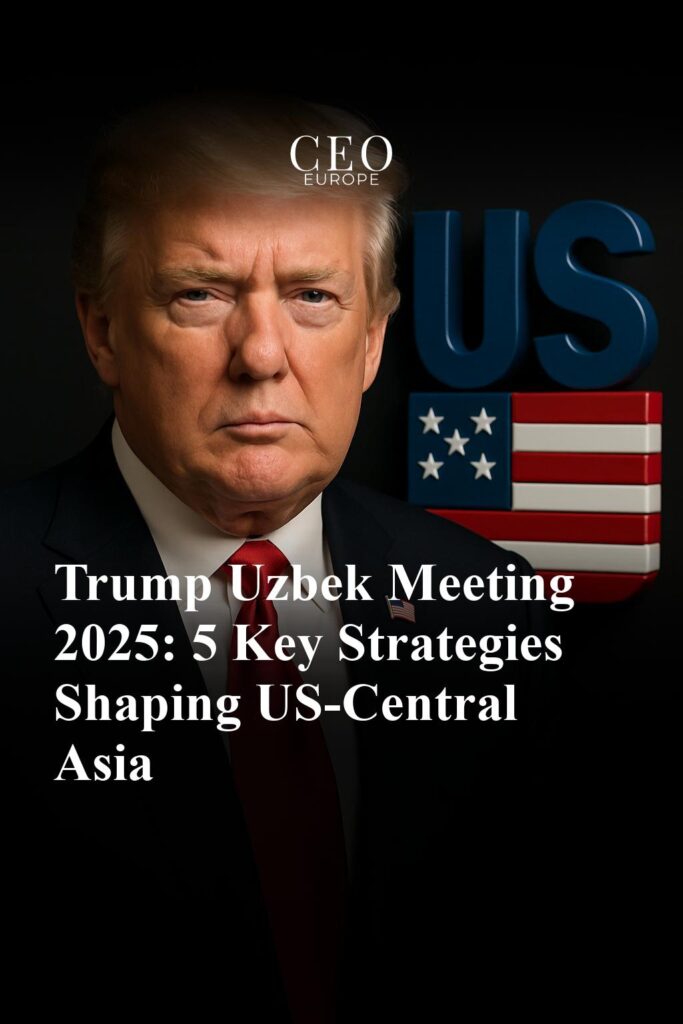1. Introduction
The Trump Uzbek meeting in 2025 marked a pivotal moment in US foreign relations, underlining the strategic importance of Uzbekistan within Central Asia. This high-profile encounter highlighted five key strategies shaping the evolving US Central Asia strategy by focusing on economic partnerships, infrastructure, and geopolitical balancing. As the US seeks to counter the expanding influence of Russia and China, Uzbekistan’s geopolitical positioning becomes increasingly critical. The discussion centered on enhancing bilateral trade, investment opportunities, and cooperative frameworks to strengthen mutual interests. This meeting not only reinforced diplomatic ties but also set the stage for long-term collaboration aimed at regional stability and economic growth.
2. Background
The 2025 meeting between former US President Donald Trump and Uzbekistan’s President Shavkat Mirziyoyev was convened amid rising global interest in Central Asia. Uzbekistan has increasingly become a focal point in US foreign relations due to its vast natural resources, strategic location, and reform-driven leadership under Mirziyoyev. Historically, US-Uzbek relations experienced fluctuations, but the recent decade saw a marked improvement in cooperation tied to security, trade, and development. This meeting built upon those foundations, emphasizing shared goals such as economic development and regional security. Uzbekistan’s role as a gateway to Central Asia presents an analogy to a “hinge” connecting East and West, underscoring its growing geopolitical significance [1].
3. Trends
Recent trends in the US Central Asia strategy vividly illustrate a shift towards deeper engagement with Uzbekistan, particularly following 2020. The US has sought to balance the assertive presence of Russia and China, both vying for influence over Central Asia’s resources and infrastructure. Uzbekistan’s openness to foreign investment has attracted nearly 300 US companies active in sectors like mineral mining and infrastructure, reflecting a growing bilateral trade relationship that has quadrupled since Mirziyoyev’s ascent. This surge in economic interaction signals a strategic pivot, with the US leveraging commercial ties as instruments of diplomacy. The example of the $8 billion Boeing Dreamliner deal from the Trump Uzbek meeting demonstrates a clear win-win scenario, creating over 35,000 jobs in the US while bolstering Uzbekistan’s aviation capacity [1].
4. Insights
The Trump Uzbek meeting revealed several insights into how infrastructure development and investment could further transform Uzbekistan geopolitics. Mirziyoyev’s proactive leadership is reshaping the country by fostering an environment conducive to business and innovation, which aligns closely with US interests. The meeting emphasized infrastructure projects as cornerstones for broadening economic ties, including transportation networks and energy facilities. It also showcased a strategic cooperation model, balancing geopolitical interests while promoting mutual economic growth. This cooperation resembles a bridge-building exercise, connecting two economies with different strengths but unified goals. Both sides recognize that deepening US-Uzbek relations can serve as a stabilizing factor in a region often influenced by competing powers, presenting opportunities for long-term development [1].
5. Forecast
Looking ahead, the US-Uzbek relationship post-2025 is poised for sustained expansion, significantly impacting Uzbekistan’s geopolitical alignment. Given the current trends, Uzbekistan may increasingly orient itself towards diversified partnerships, reducing dependency on traditional powers like Russia. This realignment could benefit US foreign relations in Central Asia by establishing a dependable ally with robust economic ties. However, it also opens scenarios where regional powers contest influence, making diplomatic agility essential. The analogy of a chessboard applies here, where Uzbekistan must carefully navigate its moves amid powerful neighbors. Long-term, the Trump Uzbek meeting signals a cornerstone for innovative diplomacy, leveraging trade and infrastructure to foster regional security and economic prosperity [1].
6. How-to
For policymakers aiming to enhance the US Central Asia strategy, the Trump Uzbek meeting provides clear directives. First, fostering transparent and sustained dialogue focused on infrastructure investment will be crucial. Second, US companies should prioritize entry into Uzbekistan’s emerging markets by aligning with local reform initiatives and regulatory frameworks. Practical steps include conducting thorough market research and partnering with Uzbek stakeholders. Finally, promoting collaborative ventures can stimulate private sector growth—an approach exemplified by the active participation of over 300 US firms in Uzbekistan’s economy. Businesses can also benefit from insights in transforming workflows with AI-centric tools, which may enhance operational efficiency in emerging markets. These strategies will solidify economic ties and project US influence constructively in Central Asia [1].
7. FAQ
What was the significance of the Trump Uzbek meeting?
The meeting reinforced the strategic partnership between the US and Uzbekistan, focusing on economic cooperation and geopolitical balance in Central Asia.
Why is the $8 billion Boeing deal important?
This deal not only modernizes Uzbekistan’s aviation but also supports over 35,000 US jobs, symbolizing mutually beneficial economic ties [1].
How will bilateral trade affect both nations?
With bilateral trade quadrupling in recent years, increased commercial exchange supports economic growth, technological transfer, and political goodwill crucial for regional stability.
What role does Uzbekistan play in US Central Asia strategy?
Uzbekistan serves as a key partner in countering regional influences and as a gateway for US economic and diplomatic engagement in Central Asia—highlighting the importance of continued strategic investment [1].
8. Conclusion
The Trump Uzbek meeting in 2025 crystallized five key strategies essential to shaping the US Central Asia strategy: strengthening trade, investing in infrastructure, balancing geopolitical interests, fostering leadership cooperation, and predicting future alignments. Uzbekistan’s emerging role as a strategic pivot offers the US an opportunity to counterbalance regional powers while promoting sustainable development. Continued engagement and strategic partnership are vital, making it imperative for stakeholders to stay informed on evolving policies and economic opportunities. As the region’s geopolitical landscape evolves, the foundations laid during this meeting present a blueprint for collaboration aimed at mutual benefit and lasting stability.
Sources and references
1. Melik Kaylan, Trump Meeting With Uzbek President: Big Strategic Win For Both Sides, Forbes, 2025.
https://www.forbes.com/sites/melikkaylan/2025/09/30/trump-meeting-with-uzbek-presidentbig-strategic-win-for-both-sides/
2. How an AI-centric browser enhances productivity in coding – CEO Europe

